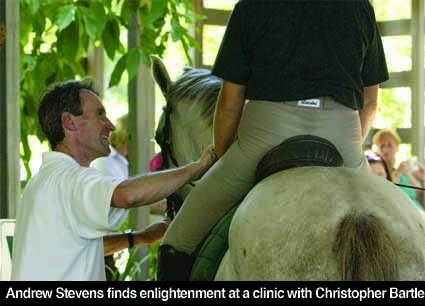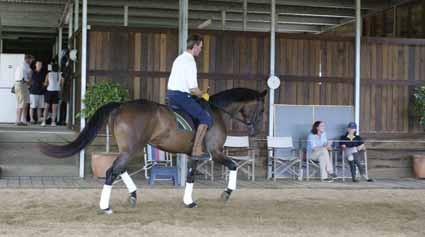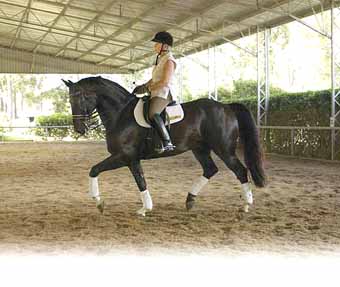An Englishman’ and ‘a world class dressage coach’. A contradiction in terms, an oxymoron perhaps? (albeit not quite in the league of “friendly fire” or “Microsoft Works” ??) The DOKR (German Committee for Olympic Riders) obviously didn’t doubt his abilities when it entered a two year contract with Christopher Bartle to coach their Three Day Event team through to the World Championships later this year, nor do Christopher’s Australian pupils who get coaching from him every summer on his annual trips to Perth, Adelaide and Brisbane.
Christopher’s feats as a competitor are world renowned: he represented Britain internationally in dressage on many occasions, being a member of their national team from 1981 to 1987, and is still the highest ever placed British dressage rider in the Olympic Games ( 6th Los Angeles 1984 with Wily Trout) and other successes include 4th at the European Championships 1985 and 2nd at the World Cup final 1986.
An illustrious eventing career has seen him rise to the heights of team gold medallist at the European Champs in 1997 and winner of Badminton**** in 1998. In recent years he has concentrated on coaching, and he is kept busy giving clinics in Europe (he is in Germany every month), Australia and the USA.
Catching up with him on his fourteenth annual trip down under I was interested to learn how this born-and-bred York-shireman became a competitor and coach at the elite level of a sport developed to an art form on the Continent.
Christopher learned his training system from a Swedish baron, Hans von Blixen-Finecke, former head of the Swedish cavalry. In 1952 Blixen-Finecke won the Olympic gold medal in the three day event and a horse he had trained won the dressage gold, ridden by the famous Swedish rider St. Cyr. The baron first went to Britain in the 1950’s to coach their national 3DE. team. Christopher started working with him back in the 70’s when he was just 24 years of age. Through until 1990 Blixen-Finecke would come to the Bartle’s centre a couple of times each year, giving Chris and his sister Jane a few weeks of intensive training.
Chris feels that about 75% of his training today was learned from the baron, and the rest is what he has picked up from his experiences as both a rider and a coach.
So what is this training system?
Chris maintains that a correctly trained dressage horse must develop in four areas:
1. Education: The horse is taught to respond to our language of touch
2. Gymnastic development: The horse is worked through exercises that put him in a position to be able to perform the movements required in dressage.
3. Physical development: The musculature and structures of the horse are strengthened to enable him to hold the collected postures required of an educated horse.
4. Mental development: The horse learns confidence and the desire to perform for the rider.
These four are inextricably related to each other. For example number 4. comes out of the previous three, and the horse needs to understand number 1 before 2 and 3 can progress.
How does Christopher teach you to do this?
His coaching is certainly very much focused on the rider. “In theory we have, as a starting point, control over our own body. As a coach I start with the rider, showing them how to communicate more effectively with their horse.”
Chris talks of the rider’s ‘body language’ and more specifically their ‘position statement’.
“Our body language is how we move when we do any physical activity such as walk, or go up stairs, or dance or ride. For example when you see a couple doing ballroom dancing, by their body language one leads and the other follows, without applying aids as such. The horse must learn to follow our body language. By using a position statement the horse learns to recognize what is required of him. There’s a position statement for all movements.”
Chris is a very technical and theoretical teacher. Almost mathematical. He would never stand in the arena and just roar commands such as ‘push him, push him’ or ‘more, more’ as has been seen from various visiting ‘experts’. Rather he will take the time to explain, in a conversation with the rider, exactly what he wants them to try to do, and this will include detailed explanation of what their position statement should be.
They then ride the exercise or movement with him giving as much assistance as he can with cues from the ground — usually relating to what their body should be doing to achieve the desired outcome. Sometimes he takes photos of the combination with a digital camera, so he can show the rider on the spot where their position is wrong. He finds it a better tool than a video as it captures the precise moment.
A session with Christopher Bartle is 45 minutes of pure concentration. Real brain work. “I’m working on the basics, and when they are right, the movements happen by themselves.”
In most movements his position statement involves four or five steps, based on the premise that for every movement there is an ‘inside of the horse.’ Let’s take the transition into canter:
1. Sit to the inside (loading the outside thigh)
2. Shorten the inside rein, and roll the arm out, keeping the elbow at or in front of the hip
3. Outside shoulder back
4. Open the inside hip, bringing knee away from saddle and put knee and toe in direction you want to go
5. Step into canter
In a trot movement, for example the preparation for a half pass, you will not require the shoulder back, and step 3 will be open the hip and 4 proceed into half pass. This might sound very simple, but the difference seen in the canter transitions of numerous pupils at the seven schools I have personally attended, when they consciously think about using these steps to control a large part of their body, rather than simply thinking “outside leg back” is a real eye-opener.
Christopher says the art of riding a good dressage test lies in the art of preparing for each movement. The rider must prepare himself, with his position statement, and then the horse understands what is required, and the movement starts. Unfortun-ately what is often seen is the converse: the rider attempts to prepare the horse, without preparing himself, and the horse does not clearly understand what is coming next.
“I’m rider focussed, but I’m also saying to riders put yourself into the position of the horse, be the horse, imagine it from his side. Think of his posture muscles. For example think of how tension in the jaw muscle leads to tension through the whole topline. If they think of those mechanics it will help them find a way to ride the horse. After all the horse does not come with an instruction manual. A dig in the ribs with a spur means something different to every horse. By correctly educating the horse to respond to our language of touch we are aiming to ride him with the lightest of aids. We must whisper to the horse, not shout, however if he is not listening to your whisper, please turn up the volume until he does.
There’s no limit to how little you can do, however there is certainly a limit to how much you can do!”
“I’m also goal centred. As a first priority ascertain what is your goal. Keep in mind your long term, medium term (that test in four weeks) and short term (what you’re working on today) goals.
My goal is to produce a dressage test that appears to happen from thought rather than action.” Chris has recently tried to boil down his training theory into a simple concise form, and has written a book. In the book he wants to put across simple concepts. In the past he has been accused of ‘overload’ as he tried to impart so much theory in his lessons. These days he is trying to impart a simple message. “My aim is to not confuse people”. He has been forced to express his concepts simply for the last year anyway, coaching the German eventing team in English, and that has helped him in the writing of the book, which will be published later this year. I asked him how he was received by the Germans:
“As with any new group of people some are very open and some are very sceptical, with others in between. Ingrid Klimke was very receptive to my ideas, and once she realised certain things helped her, her belief in my system led to other members of the team embracing my concepts. She has been particularly helped in her dressage with Concorde, by trying to sit more lightly on his back. Part of my system is that we use the leg for more energy, lift and engagement, and we use the seat simply for longer strides. The Germans complained of their horses pulling into fences at the same time as they sat heavily, and ground into their backs. We have done a lot of work on sitting lighter!”
The transformation in certain horses in this clinic as he asked the riders to sit lighter on their backs was amazing. It would appear that many horses are hampered in their efforts to perform, by the rider simply sitting too heavily at certain moments and interfering with the swing of the back. When Chris works with more advanced horses in piaffe and passage, he insists the rider sit very lightly on the horse’s back in piaffe – to drive with the seat is to ask for longer strides — you are asking for a transition to passage. The rider must adopt a piaffe position statement and then sit still as the horse offers piaffe himself. In all work Chris insists the horse has his responsibilities and the rider has his responsibilities, and neither should take over the work of the other. We should not offer to carry the horse with our hands or with continual driving aids. The horse should be in self carriage, and carry you. “You must risk the horse falling to trot from canter, rather than helping him”.
Once you have put the horse into a pace, he must maintain that pace by himself; not because you are continually driving him. If you are continually having to drive him, you have turned up the volume too high and he is no longer listening.
Of interest at this clinic was his work with Snowy River Blackwood. He felt Di Jenkyn was helping her horse too much with her half halts: “Every second stride is OK, but every fourth stride is better”. He wanted the horse to take more responsibility for his carriage.
“I told the German team from the start, the horse has his responsibilities across country too — let him alone to concentrate on what he is doing, and to decide for himself when he takes off at the fence. Don’t try and shape the horse every stride. I also want their dressage to be of sufficient quality that the horses are in genuine self-carriage. As the year has progressed it has become easier to work with them. I had to be accepted by the German media, and all the support people surrounding the team, not just the riders. Their team manager Hans Melzer has been particularly good to work with. My contract is for review after WEG. I know it hinges on their results. Like any football manager I am disposable.”
Some twenty-odd years after starting to learn from Baron von Blixen-Finecke Christopher Bartle travels the world helping riders with their dressage. The usual comment from dressage aficionados witnessing his work for the first time is that his methods are ‘different’ and ‘brilliant’. The system however is certainly not new. It is a training system rooted in the Swedish school, which saw that nation as world leaders in dressage in the early decades of the twentieth century, before the emergence of the Germans and more recently the Dutch. The Swedish cavalry developed their dressage training a century ago using ideas from the French and German schools, and Chris has learned to use the system in the coaching situation, clearly and constructively. His methods have much in common with those of Kyra Kyrklund.
“In Germany today riders learn so much by watching, and absorbing — it’s almost a process of osmosis, however you can’t do that in Australia or the USA. That lead to my teaching system developing the way it has. I have done my best to also explain it clearly in print in my upcoming book — my first attempt as an author.”
I have put my order in for a copy already. It will be fascinating reading.
One of the Stars of the clinic, Di Jenkyn and Snowy River Blackwood






